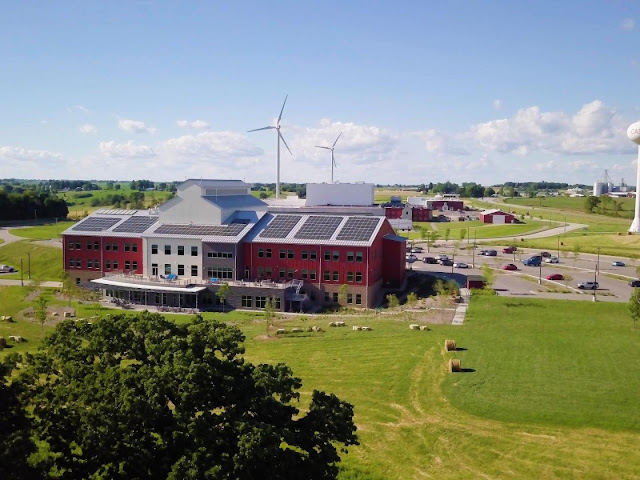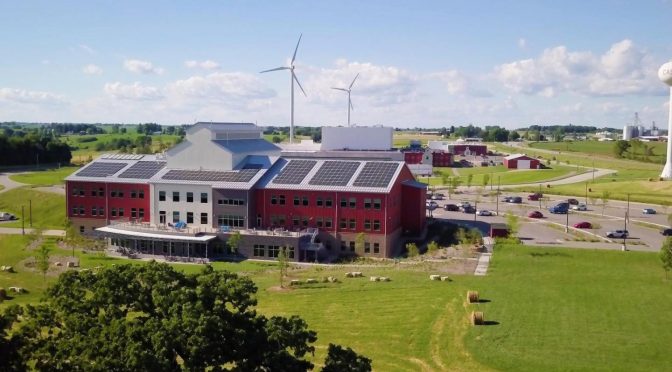The U.S. Department of Energy’s (DOE’s) Pacific Northwest National Laboratory issued its annual report on distributed wind that shows turbines used for battery charging and remote power made up 99 percent of the total number of small wind turbines last year.

The 2018 Distributed Wind Market Report highlights the very small wind turbines of less than one kilowatt in size that accounted for 99 percent of the total turbines and 47 percent of small wind project capacity deployed in 2018.
Credit
David Nevala Photography for CROPP Cooperative
Distributed wind power is clean energy generated where it is used, as opposed to power sent through transmission lines and substations. This wind power is consumed onsite by homes, schools, farms, and businesses. There are more than 83,000 wind turbines in distributed applications across the United States and its territories, which is an increase of more than 2,000 new wind turbines over the prior year. The turbines total 1,127 megawatts of distributed wind capacity.
The 2018 Distributed Wind Market Report highlights the very small wind turbines of less than one kilowatt in size that accounted for 99 percent of the total turbines and 47 percent of small wind project capacity deployed in 2018. These turbines are commonly coupled with energy storage or solar PV systems.
“As the number of small wind turbines deployed in the one- to-100-kilowatt size range has been generally decreasing, the number of deployed turbines with a capacity rating of less than one kilowatt has stayed fairly steady,” said Alice Orrell, who led the study at PNNL. “As a result, these less-than-one-kilowatt turbines, which mainly provide remote power for off-grid locations, now account for a larger share of the small wind market.”
On the other end of the size spectrum, turbines greater than one-megawatt in size are commonly used for government, commercial, industrial, and utility customers. Distributed wind projects using large-scale turbines and serving utility companies that power homes made up 47 percent of the distributed wind capacity deployed in 2018.
Another 29 percent is used by commercial and industrial customers – up from nine percent in 2017 and five percent in 2016.
Typically using smaller turbines that are no larger than 100 kilowatts, agricultural and residential customers accounted for just one percent of the documented capacity.
U.S. distributed wind capacity reached a total of 1,100 megawatts last year. Projects using turbines with greater than 100-kilowatts of wind capacity accounted for 49 megawatts of the 50.5 megawatts distributed wind capacity installed in 2018.
Texas, Iowa, and Minnesota are the top three states for overall distributed wind capacity, and Iowa, Nevada, and Alaska are the top three states for small wind capacity, although there were no new documented projects in Iowa or Nevada in 2018. Rhode Island, Ohio, and Nebraska led the United States in new distributed wind power capacity in 2018 with large-scale turbine projects. Green Development, LLC added 21 megawatts of distributed wind to its portfolio in Rhode Island in 2018, accounting for almost half of the documented 2018 distributed wind capacity and almost doubling Rhode Island’s cumulative distributed wind capacity.
New York and Alaska had the most reported small wind projects in 2018. New York has been a leader in small wind capacity deployment in past years because of its New York State Energy Research and Development Authority (NYSERDA) small wind turbine incentive program.
Now in its seventh year, the Distributed Wind Market Report was funded by DOE’s Wind Energy Technologies Office, and helps the distributed wind community — utilities, manufacturers, and federal and state agencies — keep an eye on current market conditions and regulatory environments. It provides the wind power community with a year-to-year comparison to measure growth and trends as well as data such as costs, number of deployments, performance and capacity factors, types of turbines used, customer type, domestic and international markets, and market drivers and barriers.
For more information about the distributed wind report, as well as its companion reports on utility-scale, land-based and offshore wind power, see the announcement from DOE. And, for more information about PNNL’s wind power research, visit PNNL’s wind website. Pacific Northwest National Laboratory draws on signature capabilities in chemistry, earth sciences, and data analytics to advance scientific discovery and create solutions to the nation’s toughest challenges in energy resiliency and national security. Founded in 1965, PNNL is operated by Battelle for the U.S. Department of Energy’s Office of Science. DOE’s Office of Science is the single largest supporter of basic research in the physical sciences in the United States and is working to address some of the most pressing challenges of our time. For more information, visit PNNL’s News Center.


